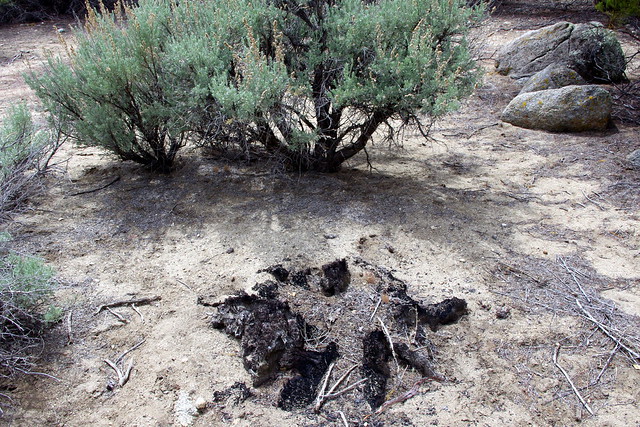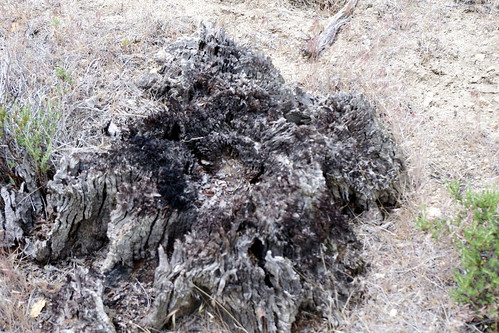It's really sad that the today's News Reports as a general rule, are mostly negative regarding our home, the Earth. Of course, if I'm not careful, I can get caught up in the same cycle of negativity spinning out of control. While I do report on many negative things as far as photos I've taken recently, there are also some positive ways of meditating on them. For example, these few photos I took below.
 |
| Photo:Mine |
Plant Forensics for Determining a Climate's Ancient Past
 |
| Photo: Mine |
 |
| Photo: Mine Utah Serviceberry Amelanchier utahensis |
 |
| Google Earth |
Location where ancient forest relics of the Jeffrey Pine stump field which amazingly still exists, though deteriorating more rapidly now. At the time of my discovery, I wondered why they were no longer thriving there. In 1982, we were still at a point of rainfall abundance during the heavy El Nino event periods of 1978-1983. Even then, pine seedling germination and establishment were at an increased high rate of success. Periods of less rainfall [mini-drought cycling] were never a past historical problem for such an ecosystem because of their defense mechanisms through rooting infrastructure and mycorrhizal networked associations within a mutualism of the plant community cooperative which ensures the health of all associated within the system. I believe that the continued land misuse and abuse by not only the increase in wildfire events, and public land mismanagement by those responsible, but even a far greater threat has been coming from small land owners who through ignorance have a total disregard when it comes to managing their own properties as Google Earth historical images clearly demonstrate.
 |
| University of Arizona Alligator Juniper Juniperus deppeana |
Aside from the lack of viable options or suggestions at the conclusions of most research papers which are strictly focused on evidence that things are getting bad, which in itself everyone already feels, one has to wonder if such studies were thoroughly done properly in the first place. One has to question, 'were they really so narrowly focused, like so much tunnel vision, that they failed to observe other clues around them which would have given further insight and understanding' ? For example, another study over in Arizona was recently released this month on August 14th, 2013, by the University of Arizona where several target species where followed. Focusing on just one of these, Alligator Juniper, where it has been noted that the tree has made a dramatic movement up in elevation and died off at lower elevations. There are a couple of paragraphs which almost mirror the observation of the upwards movement of the Santa Rosa Mountain Jeffrey Pines from that historic 4,000 feet elevation to almost 6,000 elevation. Take a close look at this one paragraph.
"For example, in 1963 Whittaker and Niering recorded alligator juniper as a component of upland desert and grassland communities in the Catalina Mountains, beginning at an elevation of just 3,500 feet. Today, one has to drive to the 5,000-foot elevation marker on the Catalina Highway to see the first live alligator juniper trees in upland habitats."Wow, sounds so familiar doesn't it ? Interesting how these same identical natural themes are occurring as one large massive western North American continental event as opposed to some restricted localized phenomena. I remember another time of unusual unnatural occurrence between the years of 1988-1990 throughout the southwest, but I wonder if anyone else remembers ? In the San Jacinto Mountains, both Jeffrey and Coulter Pines were dying off in large numbers. But this was also happening on the eastern side of the Palomar Mountain chain were almost every Coulter Pine died off. This was also repeated over at Prescott Arizona where as far as the eye could see when you came to the top of Iron Springs grade from Skull Valley, there were literally thousands of dead and dying Ponderosa Pines. Now, while this observation was all certainly very interesting and informative, does anyone else read any thing else beyond, "here is proof positive evidence of global warming or climate change" ? Yes it's all very interesting & important, but are there any viable solutions for reversing this trend ? If so what are they ? Do we need more diversity of scientific expertise from a variety of fields which allow the research to view from every angle ? Take a look at what they believed was the thoroughness of their study because of all the varying team member participants from other fields of Science.
(Source: Dramatic response to climate change in the Southwest)
"The scientists in this multidisciplinary group gathered the data during fieldwork in 2011, and included UA postdoctoral fellows and professors from several programs, including the UA departments of entomology and ecology and evolutionary biology, the Center for Insect Science and the Institute for the Environment, as well as botanists from the Arizona-Sonora Desert Museum."
But was this diverse collaboration of researchers enough ? One thing I would ask, where were the mycologists ? The Soil Scientists [Pedologist] ? The Chemists for testing water from Rainfall ? ETC! Here's what I'm leading to. In my present profession, I collect data and research from the British Isles of General Practice Doctors, Specialized Medicine, Pharmacists, Professors, etc. All data and research collection is sent back to Pharmaceutical Companies for evaluation. Incredibly, I find only mere handfuls of Doctors actually are up to scratch on the actual science and adverse reactions of the drugs they prescribe patients. Scary. One Doc I interviewed apparently uses Dice Theory when it comes to prescription recommendations. If one drug doesn't work, then oh well, let's see what this next one does. No real depth of thought goes into what motivates him. A Good Doctor knows and understands his profession. He/She doesn't merely look at the outer surface of what the mere eye observes, but goes deeper into the human system looking for a cause to outward appearing symptoms. This is what we would expect and want from any competent Doctor we'd entrust with our personal heath. If this Doctor had exhausted all his personal expertise into the matter with no result and was still unsure, then his next responsible move would be to call in a specialist. If this is what we would expect of a Physician, then what about the health of our planet ?
Here's where I'm going with this. For almost two decades I've noticed something unusual when planting nursery grown plants in the wild and inoculating with a healthy bio-diverse mix of fungal species. Not only have I noticed the normal productive growth of the target plant inoculated, but also that of the surrounding wild Chaparral Shrubs. Now, I've taken some flack and criticism by supposed experts who tell me that inoculation is NOT required (particularly in wild settings) simply existing because the spores are everywhere in the air. And yet if true, then why the poor condition of wild plants in these modern times ? This past trip I noticed an increase in poor chaparral health and I'm talking plants in locations seemingly far removed from human influence. Especially Scrub Oaks will actually prosper more. At my brothers place in Ranchita CA, I planted several Foothill Pines within the Chaparral on a hill. Not only have the Pines prospered with the mycorrhizal inoculum, but also the Scrub Oaks. I also noticed this on my own former property in Anza. There were two specific incidents where Scrub Oaks which looked as though they were struggling, suddenly come to life by their association with the pines planted and the interconnections made through the effects of the predominant PT Mycorrhizae as later Truffle formation revealed. So again, one wonders, what's going on ? Is the micro-biological world really all that healthy in the wildlands as some blindly insist ? Is this also not another area that should be explored for it's possible decline which would clearly effect what we do observe and see above the ground ? This is where other specialists on board could evaluate and report any below ground hidden abnormalities which would explain the above ground decline among other factors.
 |
| Photo: Mine |
This was taken on my old place back in 2011. I was actually looking for an example to show of a once stunted struggling Scrub Oak and the turnaround made as a result of inoculation. The Oak which was wedged in between three Coulter & Jeffrey Pines was removed as it was considered worthless. Modern Property owners have been trained by the US Forest Service that any healthy forest should reflect Garner Valley to the north of this location. Stately long tall pines with a sterile understory is the name of the game. As you can see here, the property was also stripped of it's old growth Chaparral which was in a beautiful pristine condition. Any underground networks have now been destroyed which allows for intrusion by non-native annual plants.
 |
| image: Robert L. Anderson (forestryimages.org) PT Mycorrhizae Truffle on Pine Seedlings |
Mycorrhizal Applications Inc: Don't Soils already contain mycorrhizal fungi ?
"Undisturbed soils are full of beneficial soil organisms including mycorrhizal fungi. Research indicates, however, many common practices can degrade the mycorrhiza-forming potential of soil. Tillage, fertilization, removal of topsoil, erosion, site preparation, road and home construction, fumigation, invasion of non-native plants, and leaving soils bare are some of the activities that can reduce or eliminate these beneficial soil fungi. Reintroducing mycorrhizal fungi in areas where they have been depleted can dramatically improve plant establishment and growth."
"Many routine nursery practices, such as fumigation and dousing with high levels of water and nutrients, produce non-mycorrhizal plants. When high levels of fertilizer and water are provided for non-mycorrhizal plants, they can thrive in this artificial growing media, but they are ill prepared to survive the eventual outplanted condition."
While it all makes sense on what it takes to destroy a system of it's soil microbes, are there still other things going wrong out in the wild right now that we need to know about ? Are there other explanations other than fire, drought and general climate change being blamed for ecosystem decline ?
 |
| image: MycoApply So is the Fungi present, or is it not ? |
Further References:
Warming climate pushes plants up the mountain
Response of Mycorrhizal Diversity to Current Climatic Changes
The role of mycorrhizas in forest soil stability with climate change
http://terreweb.ubc.ca/
Mission Statement of Terreweb
The goal of TerreWEB is to create an enriched, innovative, collaborative graduate training environment that addresses key scientific gaps in understanding the impacts of global change on terrestrial ecosystems and developing strategies for mitigation and adaptation, and evaluating the factors underlying global change communication deficits, developing novel communication strategies for addressing these deficits, and measuring the efficacy of those strategies."
U.S. Forest Service: "Biodiversity of Mycorrhizal Fungi in Southern California"
CALIFORNIA CHAPARRAL INSTITUTE
http://www.mycorrhizae.com/

No comments:
Post a Comment
Thanks for visiting and stopping by with your comments!
I will try to respond to each comment within a few days, though sometimes I take longer if I'm too busy which appears to be increasing.